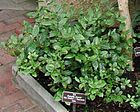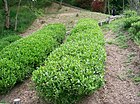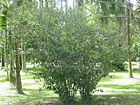Note: This is a project under development. The articles on this wiki are just being initiated and broadly incomplete. You can Help creating new pages.
Difference between revisions of "Camellia sinensis - Syamaparni"
(→Uses) |
(→Uses) |
||
| Line 3: | Line 3: | ||
==Uses== | ==Uses== | ||
| − | {{Uses|Heart problems}}, {{Uses|Teeth from decay}}, {{Uses|Dysentery}}, {{Uses|Hepatitis}}, {{Uses|Bacterial dysentery}}, {{Uses|Gastro | + | {{Uses|Heart problems}}, {{Uses|Teeth from decay}}, {{Uses|Dysentery}}, {{Uses|Hepatitis}}, {{Uses|Bacterial dysentery}}, {{Uses|Gastro enteritis}}, {{Uses|Cuts}}, {{Uses|Diarrhea}}, {{Uses|Burns}} |
==Parts Used== | ==Parts Used== | ||
Revision as of 15:02, 8 April 2019
Camellia sinensis is an evergreen plant that grows mainly in tropical and subtropical climates. Some varieties can also tolerate marine climates and are cultivated as far north as Cornwall in the United Kingdom, Perthshire in Scotland, Washington state in the United States, and Vancouver Island in Canada. In the Southern Hemisphere, tea is grown as far south as Hobart on the Australian island of Tasmania and Waikato in New Zealand.
Contents
- 1 Uses
- 2 Parts Used
- 3 Chemical Composition
- 4 Common names
- 5 Properties
- 6 Habit
- 7 Identification
- 8 List of Ayurvedic medicine in which the herb is used
- 9 Where to get the saplings
- 10 Mode of Propagation
- 11 How to plant/cultivate
- 12 Commonly seen growing in areas
- 13 Photo Gallery
- 14 References
- 15 External Links
Uses
Heart problems, Teeth from decay, Dysentery, Hepatitis, Bacterial dysentery, Gastro enteritis, Cuts, Diarrhea, Burns
Parts Used
Chemical Composition
Fresh leaves from Assam contain 22.2% polyphenols, 17.2% protein, 4.3% caffeine, 27.0% crude fiber, 0.5% starch, 3.5% reducing sugars[1]
Common names
| Language | Common name |
|---|---|
| Kannada | |
| Hindi | Cay |
| Malayalam | Teyila |
| Tamil | |
| Telugu | |
| Marathi | NA |
| Gujarathi | NA |
| Punjabi | NA |
| Kashmiri | NA |
| Sanskrit | |
| English | Tea plant |
Properties
Reference: Dravya - Substance, Rasa - Taste, Guna - Qualities, Veerya - Potency, Vipaka - Post-digesion effect, Karma - Pharmacological activity, Prabhava - Therepeutics.
Dravya
Rasa
Kashaya, Tikta
Guna
Lakhu, Rooksha
Veerya
Ushna
Vipaka
Karma
Prabhava
Habit
Identification
Leaf
| Kind | Shape | Feature |
|---|---|---|
| Simple | Bright green, shiny, often with a hairy underside |
Flower
| Type | Size | Color and composition | Stamen | More information |
|---|---|---|---|---|
| Unisexual | Yellow | 5-20 | Scented, occurring singly or in clusters of two to four |
Fruit
| Type | Size | Mass | Appearance | Seeds | More information |
|---|---|---|---|---|---|
| Brownish-green | Brownish-green, containing one to four spherical or flattened seeds | With hooked hairs | many | {{{6}}} |
Other features
List of Ayurvedic medicine in which the herb is used
- Vishatinduka Taila as root juice extract
Where to get the saplings
Mode of Propagation
How to plant/cultivate
Landscape Uses: Specimen. Prefers a woodland soil but thrives in a warm open well-drained loam if leafmould is added[3]
Commonly seen growing in areas
Tropical area, Meadows, Tolerate marine .
Photo Gallery
References
External Links
- Ayurvedic Herbs known to be helpful to treat Heart problems
- Ayurvedic Herbs known to be helpful to treat Teeth from decay
- Ayurvedic Herbs known to be helpful to treat Dysentery
- Ayurvedic Herbs known to be helpful to treat Hepatitis
- Ayurvedic Herbs known to be helpful to treat Bacterial dysentery
- Ayurvedic Herbs known to be helpful to treat Gastro enteritis
- Ayurvedic Herbs known to be helpful to treat Cuts
- Ayurvedic Herbs known to be helpful to treat Diarrhea
- Ayurvedic Herbs known to be helpful to treat Burns
- Herbs with Leaves used in medicine
- Herbs with common name in Hindi
- Herbs with common name in Malayalam
- Herbs with common name in English
- Habit - Tree
- Index of Plants which can be propagated by Seeds
- Index of Plants which can be propagated by Cuttings
- Herbs that are commonly seen in the region of Tropical area
- Herbs that are commonly seen in the region of Meadows
- Herbs that are commonly seen in the region of Tolerate marine
- Herbs






